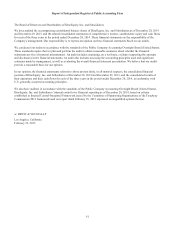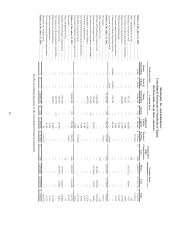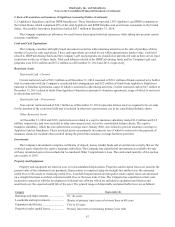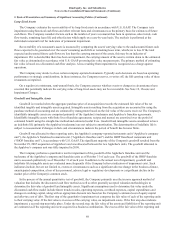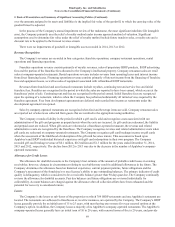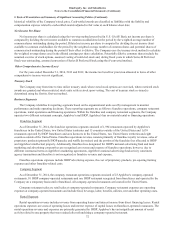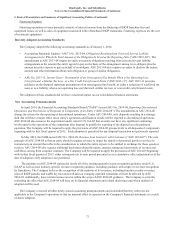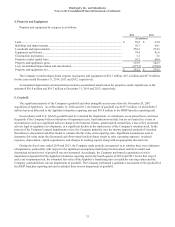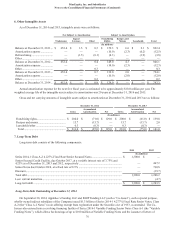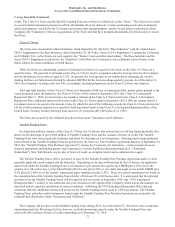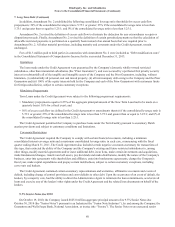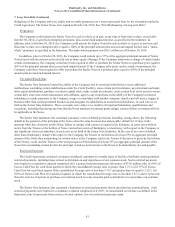IHOP 2014 Annual Report Download - page 90
Download and view the complete annual report
Please find page 90 of the 2014 IHOP annual report below. You can navigate through the pages in the report by either clicking on the pages listed below, or by using the keyword search tool below to find specific information within the annual report.
DineEquity, Inc. and Subsidiaries
Notes to the Consolidated Financial Statements (Continued)
2. Basis of Presentation and Summary of Significant Accounting Policies (Continued)
71
Fair Value Measurements
The Company determines the fair market values of its financial assets and liabilities, as well as non-financial assets and
liabilities that are recognized or disclosed at fair value on a recurring basis, based on the fair value hierarchy established in
U.S. GAAP. As necessary, the Company measures its financial assets and liabilities using inputs from the following three levels
of the fair value hierarchy:
• Level 1 inputs are quoted prices in active markets for identical assets or liabilities.
• Level 2 inputs are observable for the asset or liability, either directly or indirectly, including quoted prices in active
markets for similar assets or liabilities.
• Level 3 inputs are unobservable and reflect the Company's own assumptions.
The Company does not have a material amount of financial assets or liabilities that are required under U.S. GAAP to be
measured at fair value on either a recurring or non-recurring basis. None of the Company's non-financial assets or non-financial
liabilities is required to be measured at fair value on a recurring basis. The Company has not elected to use fair value
measurement for any assets or liabilities for which fair value measurement is not presently required.
The Company believes the fair values of cash equivalents, accounts receivable, accounts payable and the current portion of
long-term debt approximate their carrying amounts due to their short duration.
The fair values of non-current financial instruments, determined based on Level 2 inputs, are shown in the following table:
December 31, 2014 December 31, 2013
Carrying
Amount Fair Value Carrying
Amount Fair Value
(In millions)
Long-term debt, less current maturities............................... $ 1,300.0 $ 1,302.0 $ 1,203.5 $ 1,306.2
Income Taxes
The Company utilizes the liability method of accounting for income taxes. Under the liability method, deferred taxes are
determined based on the temporary differences between the financial statement and tax bases of assets and liabilities using
enacted tax rates. A valuation allowance is recorded when it is more likely than not that some or all of the deferred tax assets
will not be realized. The Company also determines its tax contingencies in accordance with U.S. GAAP governing the
accounting for contingencies. The Company records estimated tax liabilities to the extent the contingencies are probable and
can be reasonably estimated. The Company recognizes interest accrued related to unrecognized tax benefits and penalties as a
component of the income tax provision recognized in the Consolidated Statements of Comprehensive Income.
The Company recognizes the tax benefit from an uncertain tax position only if it is more likely than not that the tax
position will be sustained upon examination by taxing authorities including all appeals or litigation processes, based on its
technical merits. The tax benefits recognized in the financial statements from such a position are measured based on the largest
benefit that has a greater than fifty percent likelihood of being realized upon ultimate resolution. For each reporting period,
management applies a consistent methodology to measure and adjust all uncertain tax positions based on the available
information.
Stock-Based Compensation
Members of the Board of Directors and certain employees are eligible to receive stock options, restricted stock, restricted
stock units and performance units pursuant to the DineEquity, Inc. 2011 Stock Incentive Plan. The Company accounts for all
stock-based payments to employees and non-employee directors, including grants of stock options, restricted stock and
restricted stock units to be recognized in the financial statements, based on their respective grant date fair values. The value of
the portion of the award that is ultimately expected to vest is recognized as expense ratably over the requisite service periods.
The Company reports the benefits of tax deductions in excess of recognized compensation cost as a financing cash flow.
The grant date fair value of restricted stock and stock-settled restricted stock units is determined based on the Company's
stock price on the grant date. The Company estimates the grant date fair value of stock option awards using the Black-Scholes
option pricing model, which considers, among other factors, a risk-free interest rate, the expected life of the award and the


